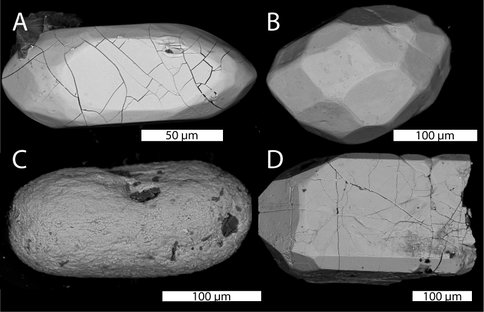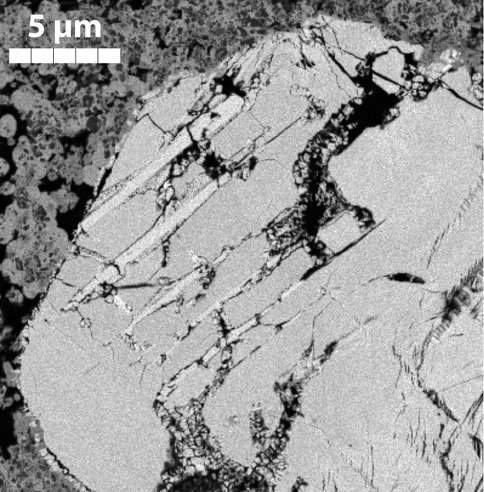2014 Annual Science Report
 University of Wisconsin
Reporting | SEP 2013 – DEC 2014
University of Wisconsin
Reporting | SEP 2013 – DEC 2014
Project 3A: Searching for Ancient Impact Events Through Detrital Shocked Zircons
Project Summary
Understanding how quickly planetary surface environments evolve on newly accreted worlds is critical for predicting when habitable conditions are established. The meteorite impact history of the inner solar system strongly indicates that the Earth was subject to a global impact bombardment during the first few hundred million years after accretion. The scope, timing, and consequences of this profound process are hotly debated. This project investigated populations of detrital zircons in Archean sedimentary rocks to search for tell-tale signs of impact processes in the form of shock-induced microstructures that are diagnostic of impact. Such features have been shown to survive in detrital shocked zircons eroded from known impact structures on Earth, including the Vredefort, Sudbury, and Santa Fe craters. We have investigated populations of 1,000 zircons per sample using backscattered electron imaging of grain exteriors with a scanning electron microscope. Thus far we have surveyed zircons separated from rocks collected from the Yilgarn craton (Australia), North China craton (China), Wyoming craton (USA), and the Superior craton (Canada). While intriguing microstructures have been observed, thus far no confirmed shock microstructures have been encountered. Our inability the identify shocked grains in populations of 1,000 zircons (per sample) does not necessarily mean shocked grains are absent; our results provide constraints that if they are present, they are in abundances of <0.1% in the detrital population of the rocks investigated. Our detailed search continues…
Project Progress
Understanding how quickly planetary surface environments evolve on newly accreted worlds is critical for predicting when habitable conditions are established (Cavosie, 2014). The meteorite impact history of the inner solar system strongly indicates that the Earth was subject to a global impact bombardment during the first few hundred million years after accretion. The scope, timing, and consequences of this profound event are hotly debated. This project investigated populations of detrital zircons in Archean sedimentary rocks to search for tell-tale signs of impact processes in the form of shock-induced microstructures that are diagnostic of impact. Such features have been shown to survive in detrital shocked zircons eroded from known impact structures on Earth, including the Vredefort, Sudbury, and Santa Fe craters. We have investigated populations of 1,000 zircons per sample using backscattered electron imaging of grain exteriors with a scanning electron microscope. Thus far we have surveyed zircons separated from rocks collected from the Yilgarn craton (Australia), North China craton (China), Wyoming craton (USA), and the Superior craton (Canada). While intriguing microstructures have been observed, thus far no confirmed shock microstructures have been encountered. Our inability the identify shocked grains in populations of 1,000 zircons (per sample) does not necessarily mean shocked grains are absent; our results provide constraints that if they are present, they are in abundances of <0.1% in the detrital population of the rocks investigated.
The detrital zircon populations were are investigating are diverse, and most have already yielded insights about Hadean Earth processes as they contain populations of Hadean zircons that contain clues about the early Earth. The specific microstructures we seek to identify in these zircons are features that are diagnostic of impact processes, as they only form under the extreme pressures (>20 GPa) generated during impact events. We focus on ancient detrital zircon to search for impact records, as our group has previously demonstrated that shocked zircons survive the process of post-impact thermal events, uplift, erosion (Cavosie et al., 2010), sedimentary transport (Erickson et al., 2013; Thomson et al., 2014; Montalvo and Cavosie, 2014), lithification and deep time preservation (Pincus et al., 2014), and metamorphism of the host rock to greenschist facies. Given the above demonstrations of process, the central hypothesis of our search is that detrital shocked zircons from early impact events on Earth should be preserved in younger (Archean) sedimentary rocks.
The populations of zircons investigated so far contain a range of zircon morphologies, ranging from euhedral to rounded grains, as is typical of diverse source rocks. However, planar microstructures, the most common shock-produced feature, have not yet been identified in the populations surveyed using backscattered electron imaging of grain exteriors. We will continue expanding our search to new populations of ancient detrital zircons in search of this important early impact record.
One of the more interesting discoveries made in 2014 was the documentation of reidite at the Rock Elm impact structure in Wisconsin. Reidite is an ultra-rare high pressure (>20 GPa) polymorph of zircon that only forms naturally during impact events. The Rock Elm reidite is an unusual discovery as it is only the fourth known locality where reidite occurs, and with an impact age of ~450 Ma, by far the oldest known occurrence. Even more interesting is that the reidite was found in a shocked detrital zircon within sandstone. This findings imply that reidite may be more common than previously reported, and provide a new mineral to investigate for studies of ancient impact records. At ~450 Ma, we’re almost back to the Precambrian!
References:
Cavosie, A.J. (2014). Reconciling early impacts and the rise of life. Geology 42, 463-464.
Cavosie, A.J., Quintero, R.R., Radovan, H.A., Moser, D.E. (2010) A record of
ancient cataclysm in modern sand: shock microstructures in detrital minerals from the Vaal River, Vredefort Dome, South Africa. GSA Bulletin, 122, 1968-1980.
Erickson, TM, Cavosie, AJ, Moser, DE, Barker, IR, Radovan HA, Wooden, J (2013b)
Identification and provenance determination of distally transported, Vredefort-derived shocked minerals in the Vaal River, South Africa using SEM and SHRIMP-RG techniques. Geochimica et Cosmochimica Acta 107, 170-188.
Montalvo, S. and Cavosie, A.J. (2014) Extreme distal transport of detrital shocked zircons
in the Orange River, South Africa: 2000 km from the Vredefort Dome to the Atlantic coast. Geological Society of America Abstracts with Programs. Vol. 46, No. 6, abstr. 317-4, p.760.
Pincus, M.R., Cavosie, A.J., Gibbon, R. (2014) Preservation of Vredefort-derived shocked
minerals in 300 Ma Dwyka Group tillite, South Africa. Geological Society of America Abstracts with Programs. Vol. 46, No. 6, abstr. 290-7, p.706.
Thomson, O.A., Cavosie, A.J., Moser, D.E., Barker, I., Radovan, H.A., and French,
B.M. (2014) Preservation of detrital shocked minerals derived from the 1.85 Ga Sudbury impact structure in modern alluvium and Holocene glacial deposits.
GSA Bulletin 126, 720-737.
Publications
-
Cavosie, A. J. (2014). Reconciling early impacts and the rise of life. Geology, 42(5), 463–464. doi:10.1130/focus052014.1
-
Valley, J. W., Cavosie, A. J., Ushikubo, T., Reinhard, D. A., Lawrence, D. F., Larson, D. J., … Spicuzza, M. J. (2014). Hadean age for a post-magma-ocean zircon confirmed by atom-probe tomography. Nature Geosci, 7(3), 219–223. doi:10.1038/ngeo2075
-
PROJECT INVESTIGATORS:
-
PROJECT MEMBERS:
Aaron Cavosie
Project Investigator
John Valley
Co-Investigator
-
RELATED OBJECTIVES:
Objective 1.1
Formation and evolution of habitable planets.
Objective 4.1
Earth's early biosphere.
Objective 4.3
Effects of extraterrestrial events upon the biosphere


